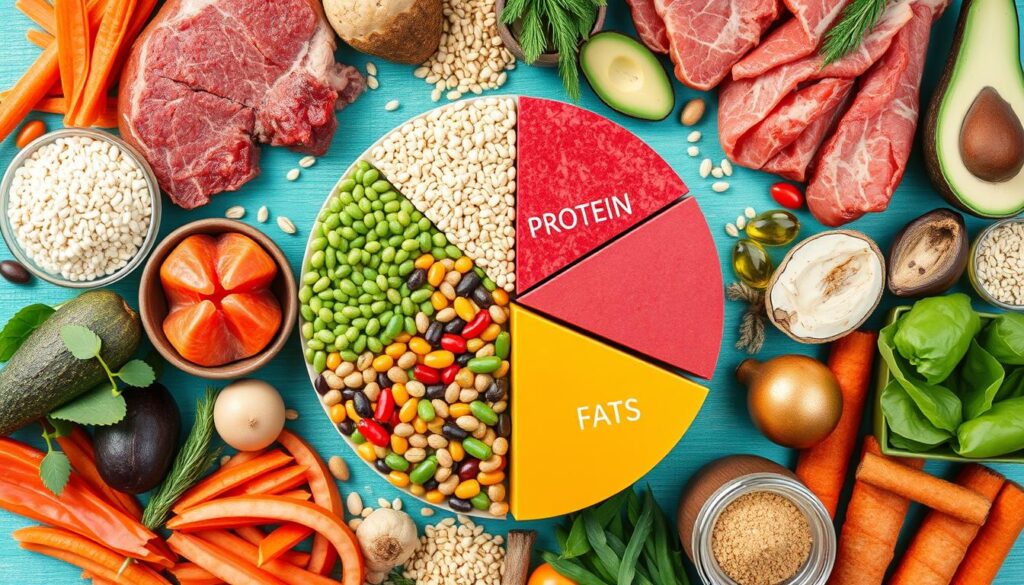Macronutrients Explained: Everything You Need to Know
Carbohydrates should be 45% to 65% of your daily calories, fats 20% to 35%, and proteins 10% to 35%. This group, called macronutrients, is key for your health and energy. Knowing about them is important for improving your diet and health.
In this introduction to macronutrients, you’ll learn the basics of what your body needs for energy, growth, and day-to-day functions. Each macronutrient has unique functions and comes from different foods. Get ready for an exciting journey into nutrition!
What Are Macronutrients?
Macronutrients are vital nutrients needed in big amounts for your body to work well. They include carbs, proteins, and fats. Each plays a key role in keeping you healthy. Think of them as a super team of nutrients, making sure you have energy and everything runs smoothly. This guide shines a light on why they’re so crucial to your diet.
Macronutrients give you energy, which is measured in calories. Carbs and proteins give about 4 calories per gram. Fats are more energy-dense, with 9 calories per gram. According to the guidelines, 45–65% of your daily calories should come from carbs, 20–35% from fats, and 10–35% from proteins. Sounds complicated, but knowing about macronutrients makes it easier!
Adults need at least 130 grams of carbs every day and enough protein based on their weight. Athletes might need more carbs and protein for energy. Diets like keto and paleo play around with these ratios for specific results. So, adjusting these macros can help your diet fit your lifestyle better.

Understanding Macronutrients: An Overview
Exploring the world of macronutrients opens up secrets about how our bodies get energy. Macronutrients play important roles. For instance, carbohydrates are our main energy source, giving 4 kcal/g. They fuel us for workouts or busy days.
Proteins are also crucial, serving as bodybuilders and repairers with 4 kcal/g. With 20 amino acids, including nine essential ones from our diet, proteins are vital. They help in muscle recovery, hormone production, and maintaining cellular structure.
Fats might seem like they’re bad, but they’re actually essential. They provide 9 kcal/g and are key for cell structure and making hormones. Understanding how to balance these macronutrients meets your dietary needs.
Learning about macronutrients from a guide can guide your dietary choices. It is suggested that diets consist of 45%-65% carbohydrates, 20%-35% fats, and 10%-35% proteins. This mix helps maintain the right energy balance for our bodies.
This balance is key to managing body weight, whether you’re trying to gain, lose, or maintain it. It’s not about removing a nutrient entirely; it’s about finding the right mix for your needs.

Introduction to Macronutrients
Learning about macronutrients can really change how you plan your meals. They are more than just fancy diet talk. They lay the groundwork for a healthy way of living. These nutrients are crucial for giving us energy, helping our bodies grow, and keeping everything running smoothly.
Definition and Importance
Macronutrients are the big nutrients our bodies need a lot of to stay healthy. They include carbs, proteins, and fats. Each has its own special benefits. Carbs give you quick energy. They’re great for when you need a boost for exercise or to get through a busy day. Proteins help with growth and fixing things in your body. Fats keep your hormones in balance and help your body take in vitamins.
Types of Macronutrients
There are different kinds of macronutrients:
- Carbohydrates: These give you fast energy. They turn into simple sugars that power your muscles and brain.
- Proteins: Made of amino acids, proteins are key for growing and repairing your body. Kids need them a lot as they grow.
- Fats: Includes saturated, unsaturated, and trans fats. Each one affects your health in its own way. Eating too much saturated fat can be bad for your heart, but omega-3 fats are good for you.
Getting to know the different macronutrients helps in making your diet better. You start to see your food in a new way. You’ll lean towards more nutritious options that give your body what it needs every day.
Macronutrient Breakdown: Carbohydrates, Proteins, and Fats
Understanding macronutrients is key to a healthy diet. Carbohydrates, proteins, and fats each have a special role in our body. For energy, carbs and proteins give us 4 calories per gram. Fats, which are denser, provide 9 calories per gram.
Carbs are our main energy source. They turn into glucose, fueling activities and brain functions. Choose complex carbs like whole grains for better energy and digestion. Adults need about 25 to 30 grams of fiber daily, but many only get 12 to 15 grams.
Proteins are vital for rebuilding our body. They become amino acids to repair tissues. A person weighing 140 pounds needs about 50 grams of protein each day. Lentils and salmon are great sources, with 18 grams and 30 grams of protein per serving respectively.
Fats give us energy and protect our organs. But we should choose healthy fats, like those in avocados and nuts, and avoid bad fats. A balanced plate has half fruits and vegetables, quarter whole grains, and quarter protein.
For more on macronutrients, check out this detailed guide. Eating right means considering each macronutrient to ensure our body gets what it needs.
Food Sources of Macronutrients
Exploring the sources of macronutrients can open your eyes. By identifying these key parts of our diet, we can create nutritious, energy-packed meals. We’ll look into the main sources of carbohydrates, proteins, and fats in our food.
Carbohydrate Sources
Carbs are our main energy fuel. They are found in:
- Whole grains, like brown rice and oats
- Fruits, including bananas and apples
- Vegetables, such as potatoes
- Legumes, including beans and pulses
These foods offer energy, vitamins, and minerals.
Protein Sources
Proteins are key for fixing tissues and cell work. You can find good protein in:
- Lean meats, like chicken and turkey
- Dairy products, such as yogurt and cheese
- Seafood, including salmon
- Plant-based choices, like tofu and lentils
Choosing a mix of these foods gives you all the crucial amino acids for a healthy diet.
Fat Sources
Fats are important for our overall wellness. Great sources include:
- Olive oil
- Avocados
- Nuts
- Fatty fish, like salmon

Adding these foods to your meals ensures you get many nutrients. This keeps your eating interesting and healthy.
Functions of Macronutrients in the Body
Macronutrients play key roles in keeping us healthy and full of energy. Each one has special jobs that help our health.
Role of Carbohydrates
Carbohydrates are our main energy source, providing 4 calories per gram. They power our daily routines and workouts. Carbs also help with digestion by keeping bowel movements regular. To stay energized, eat carbs making up 45% to 65% of your daily calories.
Importance of Proteins
Proteins fix and build up our body tissues, making them very important. They’re key in making enzymes and hormones too. Men should get about 56 grams of protein per day, and women should aim for 46 grams. Proteins should be 10% to 35% of what you eat daily to stay healthy.
Functions of Fats
Fats are essential for absorbing nutrients and protecting our organs, even though people often get them wrong. They offer 9 calories per gram and should be 20% to 35% of our daily calories. We should choose monounsaturated and polyunsaturated fats from plants. While fats are important, we need to eat less saturated fat, keeping it to 7% to 10% of our daily calories.
Macronutrients vs. Micronutrients: Key Differences
Knowing the difference between macronutrients and micronutrients is key for a balanced diet. Macronutrients are carbs, proteins, and fats that provide our energy. Micronutrients, which are vitamins and minerals, help with body functions and are needed in smaller amounts.
Macronutrients are crucial as they power our body. Carbs and proteins give us 4 calories per gram, while fats provide 9. According to Dietary Guidelines for Americans, adults should get a majority of their calories from these three sources. For muscle growth, bodybuilders may increase their protein intake.
Micronutrients include vital vitamins and minerals that boost growth and prevent disease. They are found in fruits, veggies, eggs, and fermented foods. Lack of these nutrients can cause diseases like anemia or scurvy. Not getting enough macronutrients can lead to severe issues like kwashiorkor or marasmus.

How much we consume is also important. Too much vitamins can harm the liver. Eating too many macros can result in obesity or heart disease. A balanced diet focuses on both micros and macros to keep us healthy.
What Should My Macro Breakdown Be?
Finding the right macro mix can really change your diet game. It’s about knowing the recommended macronutrient distribution for staying healthy. This can boost your energy and make you feel great. There’s a lot of advice out there, but don’t worry. We’re here to guide you through it.
Recommended Macronutrient Distribution Ranges
The USDA has some guidelines for healthy eating:
- Carbohydrates: 45-65% of total daily calories
- Protein: 10-35% of total daily calories
- Fat: 20-35% of total daily calories
On a 2,000-calorie diet, this means about 225 to 325 grams of carbs, 50 to 175 grams of protein, and 44 to 78 grams of fat each day. These are average numbers. Everyone is different. Your age, sex, how active you are, and your health goals can change your needs.
Individual Dietary Needs
Your unique macro breakdown is influenced by many personal factors. Your body type is a big factor:
- Ectomorphs: Might need more carbs (around 55%) because they handle them well.
- Mesomorphs: Can do well with a mix, like 30% protein, 40% carbs, and 30% fat.
- Endomorphs: May find success with more protein (35%), less carbs (25%), and more fat (40%).
To figure out your macros, start by calculating your Total Daily Energy Expenditure (TDEE). Then adjust your macros to fit. You can get more info on how to do this from detailed studies on macronutrient ratios.

Should You Be Counting Macros?
Counting macros is becoming popular among those looking to get fit, lose weight, or build muscle. By keeping track of carbs, proteins, and fats, people can adjust their eating plans for better health. This strategy helps target specific goals.
The usual advice is having 45% to 65% of your daily calories from carbs. Fats should be 20% to 35%, and proteins 10% to 35%. On a 2,000-calorie diet aimed at 60% carbs, you’re eating around 300 grams of carbs daily. That means lots of pasta and bread to maintain your energy!
But not everyone needs to count macros. Mindful eating, focusing on your hunger cues, works well too. If you’re thinking about counting macros, consider these points:
- Every person has different macro needs based on many factors like age and activity level.
- Apps like MyFitnessPal make it easier to track and meet your macro goals.
- It’s important to balance your intake, so you don’t eat too much of one macronutrient.
- Trying to stay within a small range of your macro targets can lead to better outcomes.
Counting macros also offers flexibility. The IIFYM (If It Fits Your Macros) approach allows for various foods, as long as they meet your macro goals. This method reminds us that the nutritional value of food matters, not just the calories.

Importance of a Balanced Diet with Macronutrients
Today’s world moves fast and eating right is key. A balanced diet with carbs, proteins, and fats isn’t only about stopping hunger. It’s about giving your body what it needs to thrive.
Getting the right mix helps keep your energy up and avoids health problems. Take the fact that over 1 billion people are short on protein. It’s a huge issue, especially for kids in places like Central Africa and South Asia where up to 30% don’t get enough protein.
A balanced diet with macronutrients includes:
- Carbohydrates: They are the main energy for your body, giving 4 kcal per gram. Your daily calories should be 45% to 65% carbs.
- Proteins: Crucial for body growth and repair, and give 4 kcal per gram. Aim for 10% to 35% of your daily calories from proteins.
- Fats: They pack the most energy with 9 kcal per gram. Healthy fats should be 20% to 35% of what you eat.
Not eating balanced can cause big health issues. Too little protein might lead to muscle loss, stunting, or a weak immune system. Sadly, over half of America’s homebound older folks don’t get enough protein. Also, eating too many carbs and fats can lead to obesity and other health problems.
To feel and think your best, choose whole foods with all three macronutrients. Next lunchtime, check if your meal is balanced. A colorful plate is good for both your body and mind!
Common Misconceptions About Macronutrients
Many people think all fats are bad and carbs are not good. But, healthy fats and complex carbs are vital for our health. Carbs are the main energy source for our bodies, giving about 4 kcal per gram. The brain uses about 20% of this energy even when we’re just sitting.
Knowing the truth about macronutrients can change how you see food. It’s important to stop believing that avoiding grains or eating very low-fat diets is the key to good health. Studies show that very low-fat diets might actually increase the chance of getting metabolic syndrome. This condition can raise your risk for heart disease. On the other hand, diets higher in fats can be better for losing weight than low-fat ones.
Some people think skipping meals, like breakfast, can help you lose weight. But this isn’t good for everyone, especially kids and pregnant women. They could face health problems if they eat meals inconsistently. For healthy people, the number of meals isn’t as crucial as meeting their energy needs.
Learning about macronutrient myths helps us make smarter food choices. A great way to start is by checking out this study on nutrition and physical activity myths for more information.
How to Assess Your Macronutrient Needs
Understanding how to figure out your macronutrient needs is crucial. It depends on your lifestyle and goals. Your age, how active you are, and any health issues matter a lot. For instance, what a young athlete needs is quite different from what a retiree requires. Learning basic calculations, such as the Mifflin-St. Jeor equation, helps you estimate your daily calorie needs. Then, you can adjust your intake of carbs, proteins, and fats.
Start by figuring out your calorie needs. Then, aim for a macronutrient split of 45-65% carbohydrates, 10-35% proteins, and 20-35% fats. For a typical 2,000-calorie diet, this means about 250 grams of carbs, 150 grams of protein, and 67 grams of fat. These numbers might change based on your specific goals. For example, building muscle means you’ll need more protein. If you’re trying to lose weight, you might cut down on fats.
Tools like macro tracking apps or keeping a food diary can be very useful. They let you see if you’re meeting your goals or if you need to adjust. Using a digital food scale ensures accuracy, and meal delivery services offer convenience. Being mindful about what you eat helps you stay on track with your health and fitness goals.
